Abstract
The polymerase chain reaction was used as the basis of a novel typing method for Neisseria meningitidis. Southern hybridization experiments demonstrated that it was possible to identify genes encoding different serological variants of the meningococcal class 1 outer membrane protein by probing with polymerase chain reaction products corresponding to known epitopes. A set of 14 defined variable regions was prepared in bacteriophage M13mp19 by the cloning of polymerase chain reaction products. The phage were dot blotted onto membrane filters, which were used as targets for hybridization of radiolabeled amplified class 1 outer membrane protein genes. Thus, the presence of many different subtype-specific epitopes could be investigated in one experiment. This technique was evaluated with a set of serological reference strains, mainly of serogroup B organisms, and provided an alternative, rapid, and comprehensive typing system that was capable of distinguishing known serosubtypes and also of defining currently untypeable strains independently of sodium dodecyl sulfate-polyacrylamide gel electrophoresis or serological analysis. An additional advantage of this technique was that in the case of an unknown serosubtype (i.e., one that did not hybridize with any of the known samples), the DNA amplified from the original sample could be used to determine the nucleotide sequence of the novel serosubtype and to clone the corresponding variable region into bacteriophage M13. It may be possible to develop this procedure for the diagnostic detection and typing of meningococci directly from clinical samples even when culture is not possible because of antibiotic treatment of an acute case.
Full text
PDF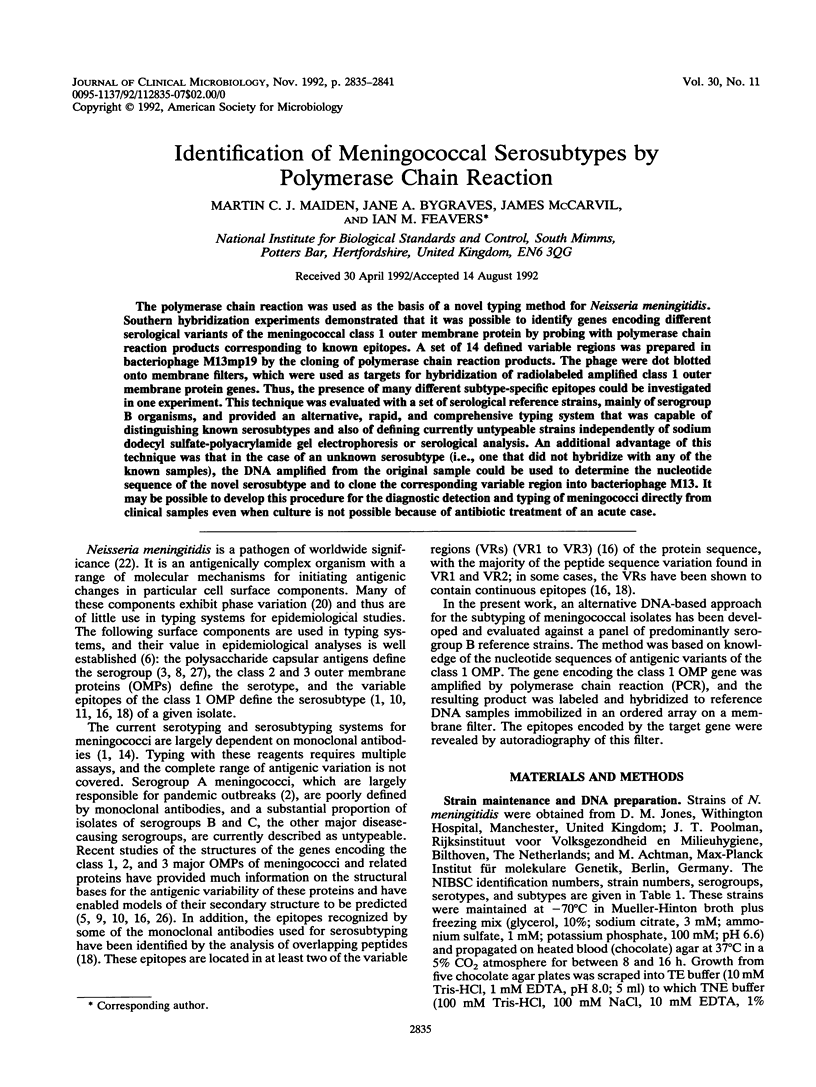

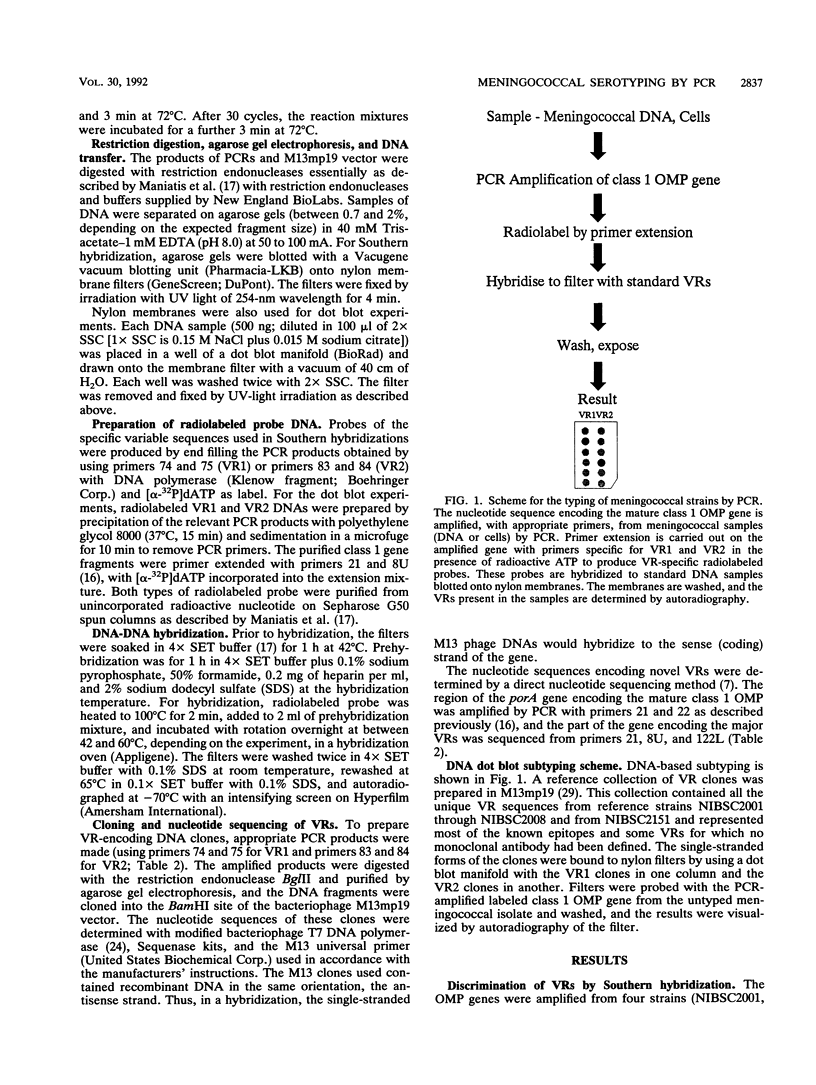
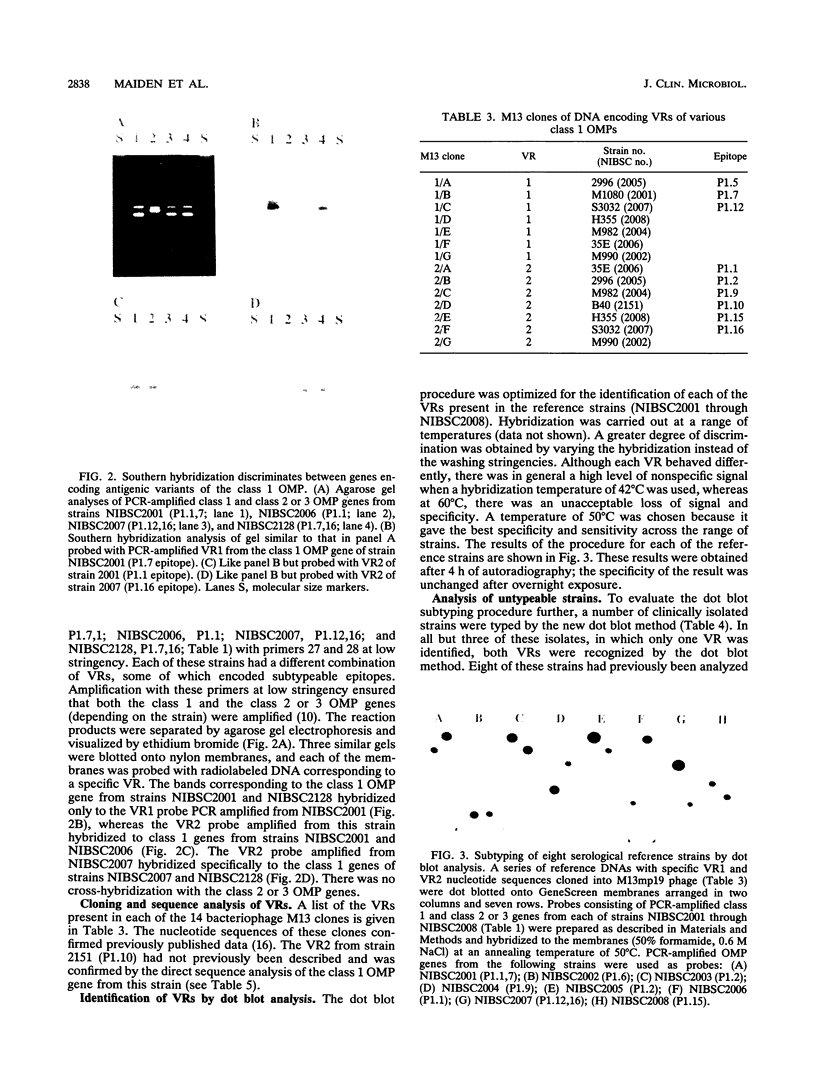
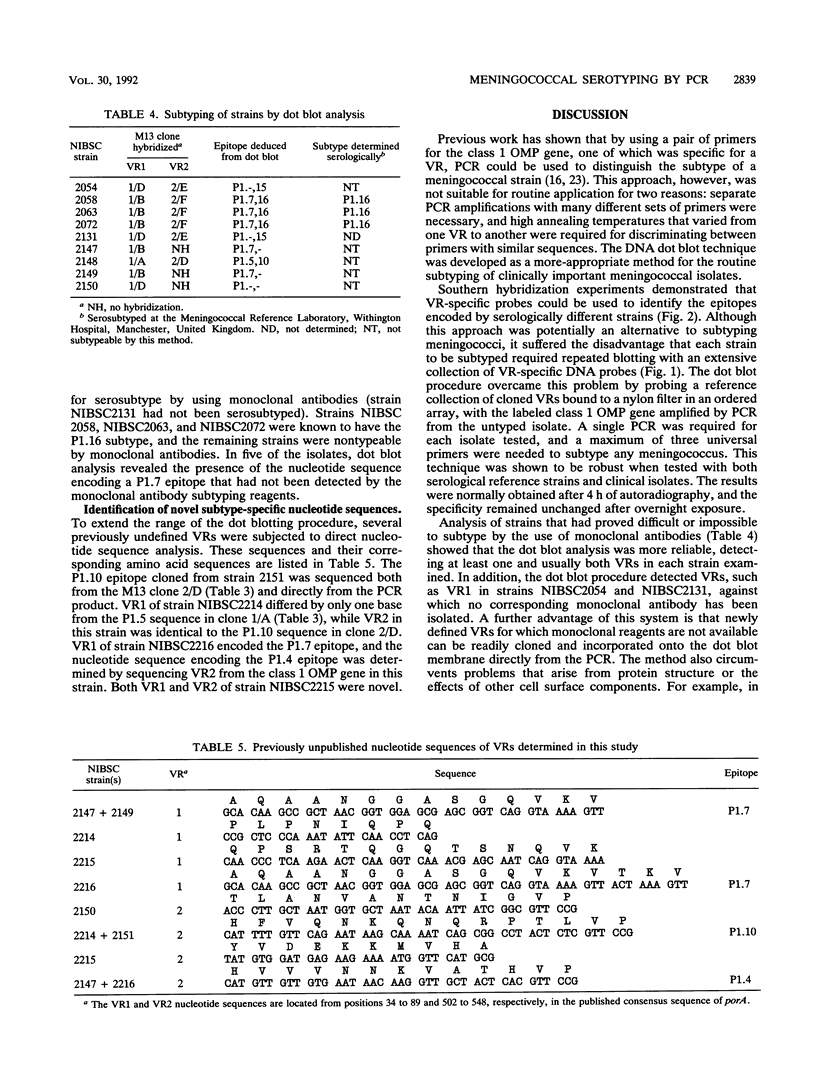
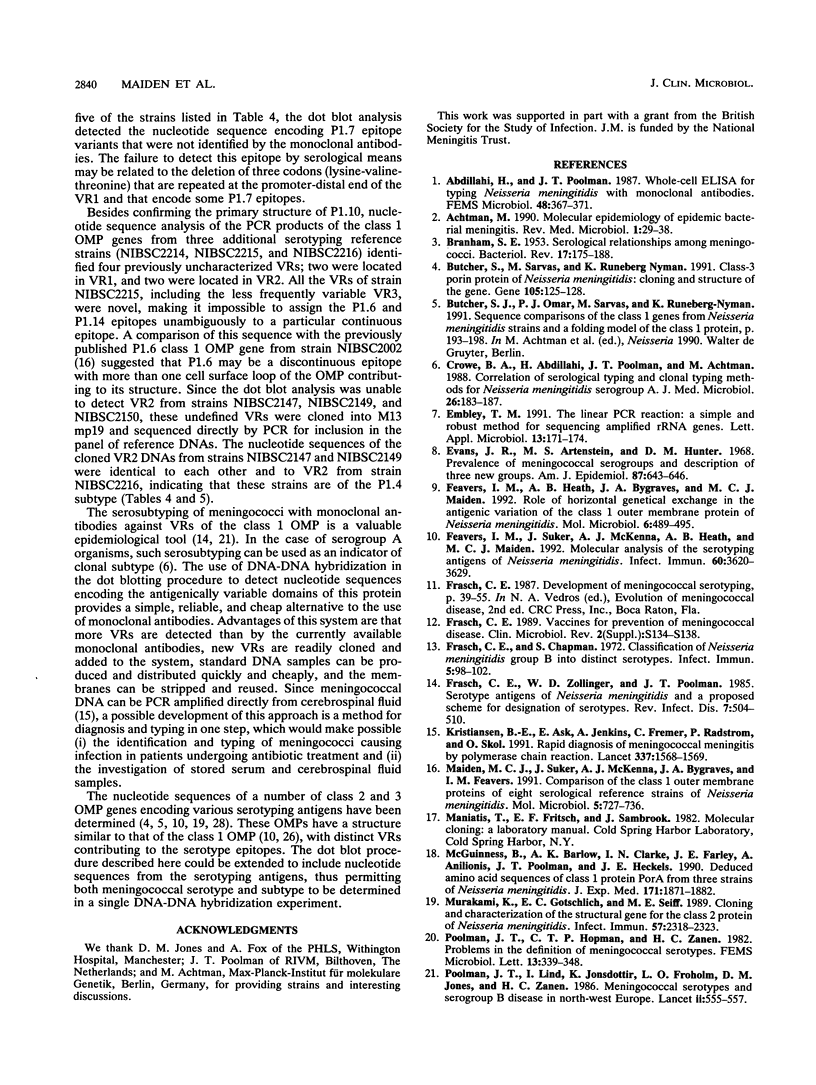

Images in this article
Selected References
These references are in PubMed. This may not be the complete list of references from this article.
- BRANHAM S. E. Serological relationships among meningococci. Bacteriol Rev. 1953 Sep;17(3):175–188. doi: 10.1128/br.17.3.175-188.1953. [DOI] [PMC free article] [PubMed] [Google Scholar]
- Butcher S., Sarvas M., Runeberg-Nyman K. Class-3 porin protein of Neisseria meningitidis: cloning and structure of the gene. Gene. 1991 Aug 30;105(1):125–128. doi: 10.1016/0378-1119(91)90523-e. [DOI] [PubMed] [Google Scholar]
- Crowe B. A., Abdillahi H., Poolman J. T., Achtman M. Correlation of serological typing and clonal typing methods for Neisseria meningitidis sero-group A. J Med Microbiol. 1988 Jul;26(3):183–187. [PubMed] [Google Scholar]
- Embley T. M. The linear PCR reaction: a simple and robust method for sequencing amplified rRNA genes. Lett Appl Microbiol. 1991 Sep;13(3):171–174. doi: 10.1111/j.1472-765x.1991.tb00600.x. [DOI] [PubMed] [Google Scholar]
- Evans J. R., Artenstein M. S., Hunter D. H. Prevalence of meningococcal serogroups and description of three new groups. Am J Epidemiol. 1968 May;87(3):643–646. doi: 10.1093/oxfordjournals.aje.a120854. [DOI] [PubMed] [Google Scholar]
- Feavers I. M., Heath A. B., Bygraves J. A., Maiden M. C. Role of horizontal genetic exchange in the antigenic variation of the class 1 outer membrane protein of Neisseria meningitidis. Mol Microbiol. 1992 Feb;6(4):489–495. doi: 10.1111/j.1365-2958.1992.tb01493.x. [DOI] [PubMed] [Google Scholar]
- Feavers I. M., Suker J., McKenna A. J., Heath A. B., Maiden M. C. Molecular analysis of the serotyping antigens of Neisseria meningitidis. Infect Immun. 1992 Sep;60(9):3620–3629. doi: 10.1128/iai.60.9.3620-3629.1992. [DOI] [PMC free article] [PubMed] [Google Scholar]
- Frasch C. E., Chapman S. S. Classification of Neisseria meningitidis group B into distinct serotypes. I. Serological typing by a microbactericidal method. Infect Immun. 1972 Jan;5(1):98–102. doi: 10.1128/iai.5.1.98-102.1972. [DOI] [PMC free article] [PubMed] [Google Scholar]
- Frasch C. E. Vaccines for prevention of meningococcal disease. Clin Microbiol Rev. 1989 Apr;2 (Suppl):S134–S138. doi: 10.1128/cmr.2.suppl.s134. [DOI] [PMC free article] [PubMed] [Google Scholar]
- Frasch C. E., Zollinger W. D., Poolman J. T. Serotype antigens of Neisseria meningitidis and a proposed scheme for designation of serotypes. Rev Infect Dis. 1985 Jul-Aug;7(4):504–510. doi: 10.1093/clinids/7.4.504. [DOI] [PubMed] [Google Scholar]
- Kristiansen B. E., Ask E., Jenkins A., Fermer C., Rådstrøm P., Skøld O. Rapid diagnosis of meningococcal meningitis by polymerase chain reaction. Lancet. 1991 Jun 29;337(8757):1568–1569. doi: 10.1016/0140-6736(91)93262-8. [DOI] [PubMed] [Google Scholar]
- Maiden M. C., Suker J., McKenna A. J., Bygraves J. A., Feavers I. M. Comparison of the class 1 outer membrane proteins of eight serological reference strains of Neisseria meningitidis. Mol Microbiol. 1991 Mar;5(3):727–736. doi: 10.1111/j.1365-2958.1991.tb00743.x. [DOI] [PubMed] [Google Scholar]
- McGuinness B., Barlow A. K., Clarke I. N., Farley J. E., Anilionis A., Poolman J. T., Heckels J. E. Deduced amino acid sequences of class 1 protein (PorA) from three strains of Neisseria meningitidis. Synthetic peptides define the epitopes responsible for serosubtype specificity. J Exp Med. 1990 Jun 1;171(6):1871–1882. doi: 10.1084/jem.171.6.1871. [DOI] [PMC free article] [PubMed] [Google Scholar]
- Murakami K., Gotschlich E. C., Seiff M. E. Cloning and characterization of the structural gene for the class 2 protein of Neisseria meningitidis. Infect Immun. 1989 Aug;57(8):2318–2323. doi: 10.1128/iai.57.8.2318-2323.1989. [DOI] [PMC free article] [PubMed] [Google Scholar]
- Poolman J. T., Lind I., Jónsdóttir K., Frøholm L. O., Jones D. M., Zanen H. C. Meningococcal serotypes and serogroup B disease in north-west Europe. Lancet. 1986 Sep 6;2(8506):555–558. doi: 10.1016/s0140-6736(86)90123-6. [DOI] [PubMed] [Google Scholar]
- Schwartz B., Moore P. S., Broome C. V. Global epidemiology of meningococcal disease. Clin Microbiol Rev. 1989 Apr;2 (Suppl):S118–S124. doi: 10.1128/cmr.2.suppl.s118. [DOI] [PMC free article] [PubMed] [Google Scholar]
- Tabor S., Richardson C. C. DNA sequence analysis with a modified bacteriophage T7 DNA polymerase. Proc Natl Acad Sci U S A. 1987 Jul;84(14):4767–4771. doi: 10.1073/pnas.84.14.4767. [DOI] [PMC free article] [PubMed] [Google Scholar]
- Tsai C. M., Frasch C. E., Mocca L. F. Five structural classes of major outer membrane proteins in Neisseria meningitidis. J Bacteriol. 1981 Apr;146(1):69–78. doi: 10.1128/jb.146.1.69-78.1981. [DOI] [PMC free article] [PubMed] [Google Scholar]
- Wolff K., Stern A. The class 3 outer membrane protein (PorB) of Neisseria meningitidis: gene sequence and homology to the gonococcal porin PIA. FEMS Microbiol Lett. 1991 Oct 1;67(2):179–185. doi: 10.1016/0378-1097(91)90351-a. [DOI] [PubMed] [Google Scholar]
- Yanisch-Perron C., Vieira J., Messing J. Improved M13 phage cloning vectors and host strains: nucleotide sequences of the M13mp18 and pUC19 vectors. Gene. 1985;33(1):103–119. doi: 10.1016/0378-1119(85)90120-9. [DOI] [PubMed] [Google Scholar]
- van der Ley P., Heckels J. E., Virji M., Hoogerhout P., Poolman J. T. Topology of outer membrane porins in pathogenic Neisseria spp. Infect Immun. 1991 Sep;59(9):2963–2971. doi: 10.1128/iai.59.9.2963-2971.1991. [DOI] [PMC free article] [PubMed] [Google Scholar]




